Abstract
Tungsten and its alloys are widely recognized as key components in high-temperature environments. In this study, self-passivating W-Si-xY alloys with varying Y content were prepared using mechanical alloying (MA) and spark plasma sintering (SPS). The synergistic effects of Y content and milling time on the microstructures and oxidation resistance of the alloys were revealed. This study found that the oxidation resistance of the alloys increased as the Y content increased. However, the effect of milling time on oxidation resistance was complex. For W-Si-xY alloys with low Y content (0Y and 2Y), the oxidation resistance decreased with increasing milling time. In contrast, for W-Si-xY alloys with high Y content (4Y and 6Y), the oxidation resistance increased with increasing milling time. This enhanced oxidation resistance is due to the microstructural changes in the protective composite layer, including the size and distribution of W5Si3, Y2Si2O7 aggregates, and W-Y-O melt. The thickness of the oxide layer on the W-Si-6Y alloy after being oxidized at 1000 °C for 2 h was only 70.7 μm, demonstrating its superior oxidation resistance.
1. Introduction
Tungsten and its alloys are widely used in various fields, including aerospace [1,2,3], armor-piercing bullets [4,5], and plasma-facing materials in nuclear fusion reactors [6,7,8]. This is due to their outstanding properties such as high melting point, high thermal conductivity, low coefficient of thermal expansion, low sputtering yield, and low tritium retention yield [9]. However, one of the disadvantages of tungsten is its poor oxidation resistance at high temperatures [10]. At temperatures of 800 °C and above, it can be oxidized to volatile WO3. To address the severe oxidation of pure tungsten at high temperatures, a self-passivating tungsten alloy was proposed [11]. The oxidation resistance mechanism of the self-passivating tungsten alloys is based on the preferential formation of a protective oxide layer on the alloy surface in air environments, which prevents further oxidation of W. Currently, the most promising self-passivating alloys are W-Cr-X (where X is the third component) and W-Si-X. Wegener et al. produced a W-Cr-Y film on sapphire substrates by magnetron sputtering. Following isothermal oxidation, a protective layer of Cr2O3 with a thickness ranging from 100 to 300 nm was detected on the surface. The alloy film exhibited a low parabolic oxidation rate, which was over five orders of magnitude lower than that of pure tungsten at 1273 K [12,13,14]. Prado et al. used a brazing technique to join a W-Cr-Y alloy to Eurofer steel with a 50 μm thick Cu interlayer, achieving high quality joints in terms of metallic continuity and strength [15]. Using the double-glow plasma surface metallurgy technology, Wang et al. prepared a W-Cr-Y self-passivation alloy layer on the surface of pure tungsten. The W-Cr-Y alloy layer, which was composed of a W(Cr,Y) solid solution and had a thickness of over 20 μm, was formed at preparation temperatures of 800, 900, 1000, and 1100 °C. The W-Cr-Y alloy layer prepared at 1000 °C exhibited the minimum oxidation mass gain and the optimal antioxidant effect [16]. Tan et al. fabricated a W-Cr-Zr thin film on sapphire substrates using magnetron sputtering. This film demonstrated superior oxidation resistance compared to the W-Cr-Y thin film under the given experimental conditions [17,18]. Elisa et al. prepared a W-Cr-Y-Zr alloy through mechanical alloying and HIP. Oxidation tests conducted at 1000 °C showed that the alloy containing Zr exhibited significantly greater oxidation resistance compared to pure W. When subjected to thermal shock loading simulating 1000 ELM-like pulses at the divertor, the heat-treated Zr-containing alloy did not exhibit any damage [19]. We prepared a W-Si alloy by mechanical alloying (MA) and spark plasma sintering (SPS). The W-Si alloy demonstrated superior high-temperature oxidation resistance compared to pure W due to the presence of a W5Si3 phase. This phase transformed into a dense WO3/SiOy composite layer on the alloy surface through the oxidation reaction [20]. However, the oxide layer at the top was porous due to the volatilization of tungsten oxide. To further enhance the oxidation resistance of the W-Si alloy, the Y element was introduced. A W-Y-O melt was formed and covered the pores, promoting the sintering of oxides in the oxide layer [21]. After oxidation in air at 1000 °C for 80 h, the oxidation rate of W-Si-Y was only 1.1% of that of pure W, and the original morphology was maintained [21]. The effect of Y content on the oxidation resistance of W-Si-Y was also investigated. The results indicated that the oxidation resistance of the alloys increased with the increase in Y content (0.0~5.0 wt.%) [22].
Milling time is a critical factor in the MA process as it can result in different microstructures of the alloys [23,24,25,26]. In a recent study, we investigated the effect of ball milling time on W-Si-xY alloys to refine their grain size and further improve their properties. Our findings indicated that the oxidation resistance of the alloys with or without low Y content (≤2 at%) prepared by long-time ball milling (20~40 h) was worse than those prepared by short-time ball milling (4~5 h). The alloys with high Y content (2~6 at%) exhibited the opposite effect. This means that Y content and milling time have a synergistic effect on the microstructures and oxidation resistance of self-passivating W-Si-xY alloys. Thus, in this work, W-Si-xY powders with varying Y content were prepared using two representative milling times (4 h and 20 h). The powders were then sintered into bulks using SPS. The microstructures and oxidation resistance of the alloys were investigated in order to clarify the synergistic effects of Y content and milling time.
2. Materials and Methods
Elemental powders of W (99.9% purity, 1~5 μm), Si (99.9% purity, ~1 μm) and Y (99.9% purity, ~15 µm) were used to produce W-32Si-xY (x = 0, 2.0, 4.0, 6.0 at.%) alloys. For convenience, the W-32Si-xY compositions were labeled as xY (x represents yttrium content). The MA, SPS, and oxidation processes were performed according to our previous report [20,21,22]. The powders, weighed according to the ratio with 5 wt.% of ethanol, were mechanically milled in a high-energy planetary ball mill under an Ar atmosphere at room temperature [20]. Tungsten carbide (WC) balls were adopted. The ball-to-material weight ratio (BPR) was 15:1 [20]. The rotation speed was 250 rpm [20], and the milling times were 4 h and 20 h, respectively. The SPS process was conducted with the SPS equipment (Sinter land, LABOX-1575, Nagaoka, Japan), where powders were consolidated into cylinders at 1550 °C for 5 min at 50 Mpa [22]. The size of the sintered cylinders was 20 mm in diameter and 4 mm in thickness.
The cylinders were processed into cubes with a size of 4 × 4 × 4 mm3 by wire-electrode cutting, and these cubes were successively ground by 15 μm and 5 μm diamond papers, and finally polished with diamond suspension until the six surfaces were mirrored [22]. Oxidation tests were conducted in a high-temperature box resistance furnace with a heating rate 10 °C/min from room temperature to 1000 °C in air [22]. The cubes were held at 1000 °C and lasted from 0 h to 10 h [22]. The weight of each specimen was measured using an electronic balance with an accuracy of 0.1 mg before and after oxidation. Three parallel specimens were adopted in each oxidation test.
The oxygen content in the powders was measured by the ONH analyzer (G8 Galileo, Bruker, MA, USA). The phase composition of the materials was determined by an X-ray diffractometer (XRD 7000, Shimadzu, Kyoto, Japan), with a tube voltage 40 kV, and a tube current 30 mA; the source of the ray was Cu-Kα. Microstructure and composition were observed with a scanning electron microscope (SEM, Nova NanoSEM 450, FEI, Eindhoven, The Netherlands) and an energy dispersive spectrometer (EDS). In order to observe the cross-section of the oxide layer on the surface of the cube, a wire cutting method was used to cut the oxide cube from the middle of the surface.
3. Results and Discussion
3.1. Microstructures of the As-Prepared Powders
Figure 1 shows the SEM images of as-prepared W-Si-xY powders milled for 4 h and 20 h, respectively. With the increase in Y content, the particle size of the powders decreased and a change in shape from irregular to spherical occurred. This indicates that Y is beneficial for the refinement of W particles. Furthermore, at the same Y content, the powders milled for 20 h had finer particles than those milled for 4 h.

Figure 1.
SEM images of as-milled W-Si-xY powders: (a) 0Y, (b) 2Y, (c) 4Y, and (d) 6Y; milled for (1) 4 h and (2) 20 h.
Figure 2 presents the EDS-mapping of the 2Y and 6Y powders milled for 4 h and 20 h, respectively. The Y distribution in the 2Y and 6Y powders milled for 4 h was uneven, with locally Y-enriched areas (marked with yellow circles). On the contrary, after 20 h of milling, the distribution of W, Si and Y in 2Y and 6Y powders was similar, indicating that these elements were uniformly dispersed in the particles.
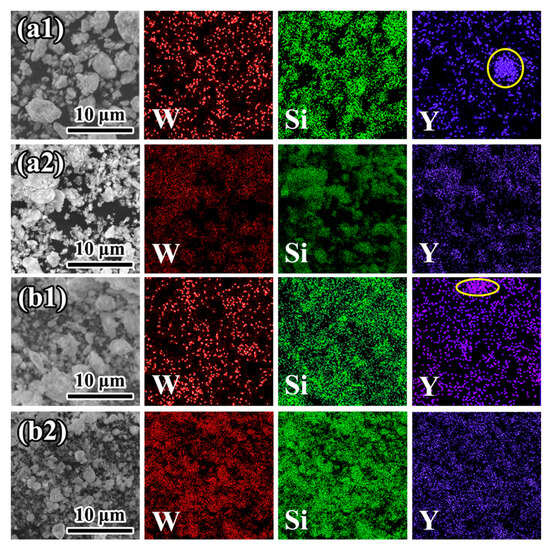
Figure 2.
EDS-mapping images of (a) W-Si-2Y and (b) W-Si-6Y powders milled for (1) 4 h and (2) 20 h.
The XRD patterns of the as-prepared powders milled for 4 h and 20 h are shown in Figure 3. Peaks of W and Si were detected in all samples. No peaks of Y were observed, probably because the Y content was too low to reach the XRD detection limit.

Figure 3.
XRD patterns of W-Si-xY powders milled for (a) 4 h and (b) 20 h.
3.2. Microstructures of W-Si-Y Sinter Alloys
The XRD patterns of W-Si-xY alloys sintered using the powders milled for 4 h and 20 h are shown in Figure 4. These XRD patterns are similar, in that W and W5Si3 are the main phases, and a weak SiO2 diffraction peak is also detected. This indicates that during the sintering process, most of the Si reacts with W to form W5Si3, while a small amount reacts with O to form SiO2. The formation process of W5Si3 and SiO2 has been discussed in a previous report [20]. Although the XRD did not detect any Y-containing phases, XPS analysis confirmed the presence of Y, Y2O3, and Y-Si-O in all the W-Si-Y alloys [22].
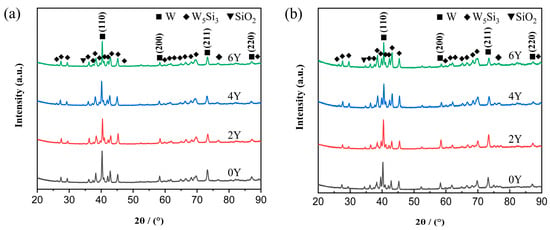
Figure 4.
XRD patterns of sintered alloys made from powders milled for (a) 4 h and (b) 20 h.
The BSE-SEM images of sintered alloys are shown in Figure 5a–d. All the alloys consist of black particles (marked as A), gray phase (marked as B), and bright gray phase (marked as C). The details of these phases have been studied previously [20,21,22]. Based on our reports and EDS results, the gray phase B is W5Si3 and the bright gray phase C is W. In the 0Y alloy, the black particles A are SiOx (x = 1, 2, 3), while in the Y-containing alloys, they are SiOx, Y, Y2O3, and Y-Si-O. In the 2Y alloy, the amount of Y2O3 and Y-Si-O is lower, but it increases with higher Y content. In the 4Y and 6Y alloys, the content of Y2O3 and Y-Si-O is comparable to that of SiOx.
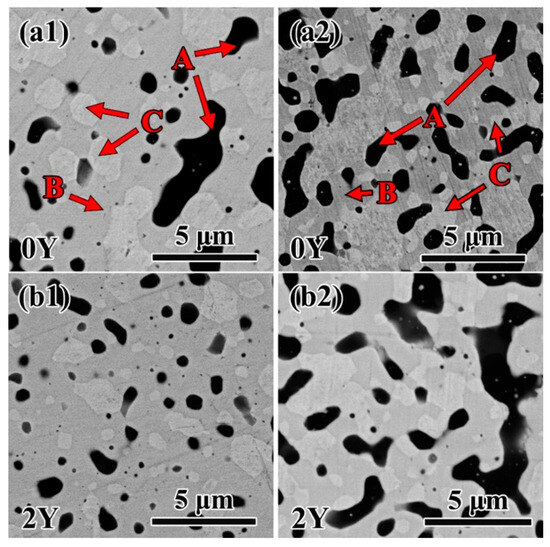
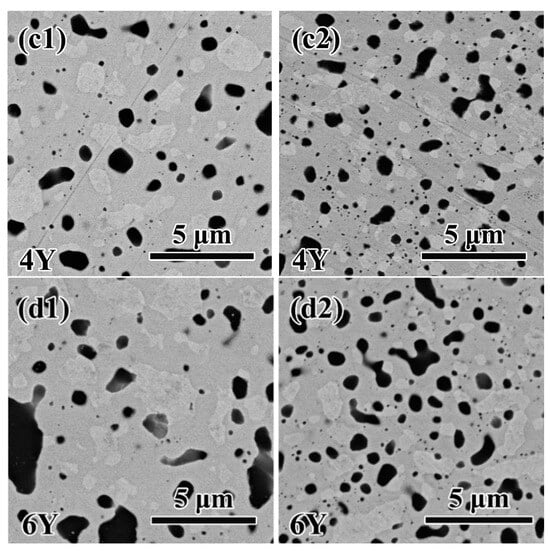
Figure 5.
BSE-SEM images of sintered W-Si-xY bulks: (a) 0Y, (b) 2Y, (c) 4Y, and (d) 6Y; (1) 4 h milling, (2) 20 h milling.
The distribution of the W5Si3 phase is crucial for the oxidation resistance of W alloys [20]. It was observed that the W5Si3 phase was discontinuous in the 0Y and 2Y alloys made from 20 h milled powders. In contrast, the W5Si3 phase was continuous in the other alloys. The melting point of silicon is 1410 °C, which is lower than the sintering temperature (1550 °C). In addition, long-time milling renders the powders higher reactivity, leading them to adsorb more oxygen. The oxygen content of the powders milled for 20 h was about 21,000 ppm, which was higher than that of the powders milled for 4 h (~12,000 ppm). These factors promoted the formation of large SiO2 particles in the 0Y and 2Y alloys made from 20 h milled powders, resulting in the separation of the W5Si3 phases. However, for the 4Y and 6Y alloys made from 20 h milled powders, most of the oxygen reacted with Y to form Y-rich oxide particles because Y has a higher affinity to O than Si and the Y content was high. Yttrium has a high melting point (1522 °C) and was uniformly dispersed in the powder. Therefore, fine Y-rich oxide particles could be formed during the sintering process without splitting the W5Si3 phase.
3.3. Oxidation Tests
Figure 6 shows the specific weight change in the alloys after oxidation at 1000 °C at different times. Except for the 2Y alloy made from 20 h milled powders, the oxidation weight gain of all other alloys decreased with the addition of Y. In addition, under the same oxidation conditions, the weight gain of the 0Y and 2Y alloys made from 20 h milled powders was much higher than for the same composition alloys made from 4 h milled powders; the weight gain of the 4Y and 6Y alloys made from 20 h milled powders was close to or even lower than that of the same component alloys made from 4 h milled powders.

Figure 6.
Weight change in the alloys made from powders milled for (a) 4 h and (b) 20 h after oxidation at 1000 °C at different times; (c) the details of 4Y and 6Y alloys.
Figure 7 shows the macro-morphology of the alloys after oxidation at 1000 °C at different times. Due to the tip thermal effect [27], the oxidation of all alloys was preferentially initiated from the angular edges of the cubes. As the oxidation progressed, the edge oxidation layer split and curled to two adjacent surfaces of the cube, respectively. Except for the 0Y and 2Y cubes made from 20 h milled powders, the oxide layers on the six surfaces of the other cubes were uniform and flat. Compared to the 0Y and 2Y alloys made from 4 h milled powders, the oxidation of the 0Y and 2Y alloys made from 20 h milled powders was more serious under the same oxidation conditions. Especially after oxidation for 10 h, the oxide scale grew outward strongly and damaged their cubic shapes. The oxidation process of pure tungsten and this observed phenomenon are similar, suggesting that oxidation occurs cyclically through periodic cracking in localized areas when a dense tungsten oxide layer reaches a critical thickness [28]. However, the appearance of 4Y and 6Y made from 20 h milled powders was similar to that of the same composition alloys made from 4 h milled powders, and they all maintained good cubic morphology. This indicates the formation of a durable protective layer on the surface of the alloys.

Figure 7.
Macro photos of W-Si-xY alloys made from powders milled for (a) 4 h and (b) 20 h after oxidation at 1000 °C for 2 h and 10 h.
3.4. Microstructure of Oxidation Layer Analysis
In order to explain the above phenomenon, the microstructure of the alloys oxidized for 2 h was characterized.
Figure 8 shows the SEM images of the surface of the preferential oxidation region (as shown by the arrow in Figure 7) of the alloys oxidized for 2 h. For all the alloys, the oxidation region was composed of a porous network layer and some particles. The porous network was confirmed to be a WO3/SiO2 composite, and the particles were WO3, SiO2, W-Fe-O, W-Y-O, etc. [20,21]. Those large black holes were a result of the volatilization of WO3 or the shedding of some SiO2 particles. It was noticed that the WO3/SiO2 composite layer was discontinuous in the 0Y and 2Y alloys made from 20 h milled powders, but continuous in other alloys. The WO3/SiO2 composite was formed by the in situ oxidation of W5Si3, so the distribution of the composite was closely related to the W5Si3 distribution in the alloy. As mentioned above, in the 0Y and 2 Y alloys made from 20 h milled powders, W5Si3 was discontinuously distributed, so was the WO3/SiO2 composite.
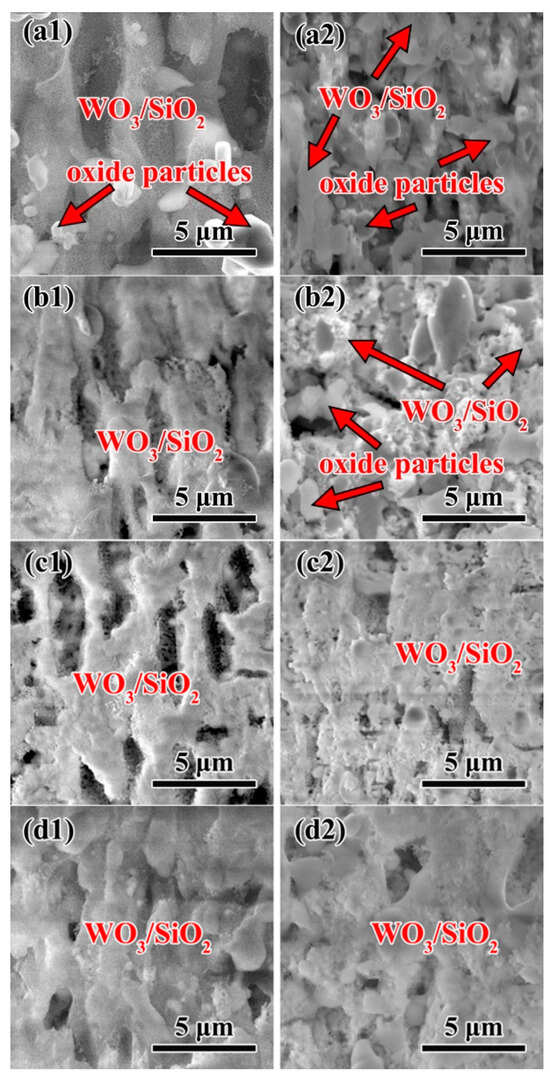
Figure 8.
SEM images of the preferential oxidation region of W-Si-xY alloys oxidized for 2 h: (a) 0Y, (b) 2Y, (c) 4Y, (d) 6Y; (1) 4 h of milling, (2) 20 h of milling.
Figure 9 shows the cross-section BSE-SEM images of the alloys oxidized for 2 h. The thicknesses of the oxide layers in Figure 9 are listed in Table 1. As the Y content increased, the oxide layer thickness decreased. For the 0Y and 2Y alloys made from 20 h milled powders, the oxide layer was much thicker than that made from 4 h milled powders. For the 4Y and 6Y alloys, the opposite was true. In the oxide layer, the oriented bright grey phase is WO3 and the dark grey phase is WO3/SiO2 (the typical images are shown in the inset of Figure 9(b1,c2), which are derived from the in situ oxidation of W and W5Si3 in the alloy, respectively). The black particles in the oxide layer of 0Y alloys are SiO2. When yttrium is added to the alloy, Y2Si2O7 aggregates with black edges appear (the inset of Figure 9(d1) is an enlarged image of Y2Si2O7 aggregates). The quantity and dimensions of these aggregates rose as the Y content increased. The black edge is a micro-crack resulting from the different thermal expansion coefficients of Y2Si2O7 aggregates and the WO3/SiO2 oxide layer. Further information on WO3, WO3/SiO2, and Y2Si2O7 aggregates can be found in our report [21,22].
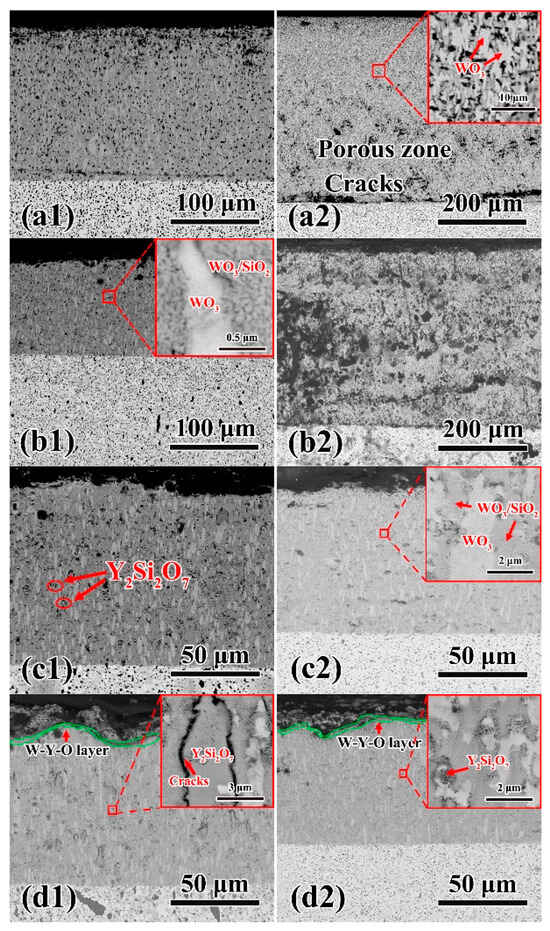
Figure 9.
BSE-SEM images of the cross-sections of W-Si-xY samples after oxidation at 1000 °C for 2 h: (a) 0Y, (b) 2Y, (c) 4Y, and (d) 6Y; (1) 4 h of milling, and (2) 20 h of milling.

Table 1.
Oxide layer thickness of the oxidized W-Si-xY alloys in Figure 9.
For the 0Y alloy made from 4 h milled powders, the WO3/SiO2 composite oxide forms a continuous phase, and there are no obvious cracks or holes are found at the interface between the alloy and oxide layers. However, for the same composition alloy made from 20 h milled powders, the WO3/SiO2 composite oxide is a discontinuous phase, which mixed with other oxide particles (the inset of Figure 9(a2)), and transverse cracks and porous bands appear at the alloy/oxide layer interface. At the interface between the oxide layer and the alloy, if the rate of new oxide formation is lower than that of oxygen diffusing to the interface, there will be residual oxygen. As the oxidation time increases, more and more residual oxygen will be stored at the interface, resulting in the formation of a porous zone that separates the oxide layer from the alloy [29,30]. Compared to the 0Y alloy made from 4 h milled powders, the protective WO3/SiO2 phase in the alloy made from 20 h milled powders is discontinuous. This allows more oxygen to enter the interface at a faster rate, making it easier for cracks and multiple voids to form at the interface. The microstructure of the oxide layer of the 2Y alloy is similar to that of the 0Y alloy.
For the 4Y and 6Y alloys made from 4 h and 20 h milled powders, their WO3/SiO2 composite oxide forms a continuous phase, and no obvious cracks or holes are found at the interface. Furthermore, compared to the alloys made from 4 h milled powders, the Y2Si2O7 particles in the oxide layer of the alloys made from 20 h milled powders are finer, resulting in smaller cracks around them. These cracks are isolated and do not interconnect with each other to form penetrating channels for oxygen. Therefore, they have little effect on the oxidation resistance of the alloys.
It is known that the oxide layer of W-Si-6Y alloys have three layers from inside to outside: a dense WO3/SiO2 layer, a loose WO3/SiO2 layer, and a W-Y-O molten layer [21]. The molten layer also plays an important role in the oxidation resistance of the alloy, which can slow down the diffusion of oxygen from the environment into the alloy. The molten layer can be observed in 6Y alloys, as shown in Figure 9(d1,d2), while it is difficult to observe in 2Y and 4Y alloys. For alloys with low Y content, the W-Y-O melt is insufficient to form a continuous phase. However, as the Y content increases, the melt increases and then forms a continuous phase [22]. Therefore, the oxidation resistance of the 6Y alloy is higher than that of the 4Y alloy.
The above results show that the oxidation resistance of the W alloy is influenced by W5Si3, W-Y-O molten layer, and Y2Si2O7 aggregates. For allows with low Y content (0Y and 2Y) made from 20 h milled powders, long-time milling introduces more oxygen and causes silicon to have higher reactivity, forming larger SiO2 particles in the alloys, thereby resulting in the separation of the W5Si3 phases. Therefore, the WO3/SiO2 composite oxide layer, formed by the in situ oxidation of W5Si3, is not continuous. The oxidation resistance of the 0Y and 2Y alloys prepared by short-time milling is better than that of the alloys prepared by long-time milling.
For the alloys with high Y content (4Y and 6Y) made from 20 h milled powders, although the oxygen content is higher, the majority of the oxygen reacts with Y to form small-sized, Y-rich oxide particles. Therefore, W5Si3 remains continuous, thereby providing an effective and continuous oxide protective layer for the alloys. Furthermore, with the increase in milling time, Y becomes more refined and uniformly dispersed. As a result, the Y2Si2O7 particles formed by oxidation are smaller, which has little adverse effect on the oxidation resistance of the alloy. Therefore, the 4Y and 6Y alloys made from 20 h milled powders exhibit better oxidation resistance compared to the same composition alloys made from 4 h milled powders.
Furthermore, for the alloys with high Y content, a continuous W-Y-O melt can form on the outmost surface to further improve oxidation resistance.
4. Conclusions
The synergistic effects of Y content and milling time on the microstructure and oxidation resistance of W-Si-Y alloys were investigated. It is found that milling time affects the distribution of W5Si3 and the size of Y2Si2O7 aggregates, which are the key factors in oxidation resistance. During the oxidation process, the continuous W5Si3 phase can transform into a dense, protective WO3/SiOy composite layer on the surface of the alloy through an oxidation reaction, which hinders the oxidation of the internal alloy. At the same time, Y2Si2O7 aggregates are formed in the Y-containing alloys. Cracks appear around the Y2Si2O7 aggregates due to the different thermal expansions of the Y2Si2O7 aggregates and the WO3/SiOy oxide layer. If the cracks are isolated and do not connect with each other to form penetrating channels for oxygen, they have little effect on the oxidation resistance of the alloys.
For the 0Y and 2Y alloys, the oxidation resistance of the alloys made from 20 h milled powders is worse than that of the alloys made from 4 h milled powders. This is because the W5Si3 phase in these alloys made from long-time-milled powders is discontinuous, so the formed WO3/SiOy composite oxide layer is also discontinuous and cannot prevent the oxidation of the internal alloy.
For the 4Y and 6Y alloys, the oxidation resistance of the alloys made from 20 h milled powders is better than that of the alloys made from 4 h milled powders. There are two main reasons: one is that W5Si3 in the alloys is a continuous phase; the other is that the Y2Si2O7 particles in the alloy made from powders by long-time milling are smaller than those prepared by short-time milling, so their surrounding cracks are smaller. These cracks are more difficult to connect with each other to form oxygen channels.
Author Contributions
Conceptualization, L.X.; funding acquisition, Y.Y. and Q.Z.; investigation, S.C.; methodology, S.C. and L.X.; project administration, L.X.; resources, S.Y., Y.Y. and Q.Z.; supervision, L.X. and Y.Y.; visualization, S.C.; writing—original draft, S.C. and L.X.; writing—review and editing, S.C. and S.Y. All authors have read and agreed to the published version of the manuscript.
Funding
This research was funded by the National MCF Energy R&D Program, grant number 2018YFE0306104 and the State Key Laboratory of Materials Processing and Die & Mould Technology, Huazhong University of Science and Technology, grant number P2023-024.
Data Availability Statement
The data used to support the findings of this study are available from the corresponding author upon request. The data are not publicly available due to privacy.
Acknowledgments
The authors thank the analytical and testing center at Huazhong University of Science and Technology for their help.
Conflicts of Interest
The authors declare no conflicts of interest.
References
- Wang, Y.J.; Peng, H.X.; Zhou, Y.; Song, G.M. Influence of ZrC content on the elevated temperature tensile properties of ZrCp/W composites. Mater. Sci. Eng. A 2011, 528, 1805–1811. [Google Scholar] [CrossRef]
- Kharchenko, V.; Bukhanovskii, V. High-temperature strength of refractory metals, alloys and composite materials based on them. Strength Mater. 2012, 44, 512–517. [Google Scholar] [CrossRef]
- Zheng, X.; Bai, R.; Wang, D.H.; Cai, X.M.; Wang, F.; Xia, X.M.; Yu, L.J. Research Development of Refractory Metal Materials Used in the Field of Aerospace. Rare Met. Mater. Eng. 2011, 40, 1871–1875. [Google Scholar]
- Kolmakov, A.; Bannykh, I.; Antipov, V.; Vinogradov, L.; Sevost’yanov, M. Materials for bullet cores. Adv. Mater. Technol. 2021, 4, 351–362. [Google Scholar] [CrossRef]
- Benedetto, G.; Matteis, P.; Scavino, G. Impact behavior and ballistic efficiency of armor-piercing projectiles with tool steel cores. Int. J. Impact Eng. 2018, 115, 10–18. [Google Scholar] [CrossRef]
- Pitts, R.; Bonnin, X.; Escourbiac, F.; Frerichs, H.; Gunn, J.; Hirai, T.; Kukushkin, A.; Kaveeva, E.; Miller, M.; Moulton, D.; et al. Physics basis for the first ITER tungsten divertor. Nucl. Mater. Energy 2019, 20, 100696. [Google Scholar] [CrossRef]
- Cheng, Z.Y.; Sun, J.R.; Gao, X.; Wang, Y.Y.; Cui, J.H.; Wang, T.; Chang, H.L. Irradiation effects in high-entropy alloys and their applications. J. Alloys Compd. 2023, 930, 166768. [Google Scholar] [CrossRef]
- Bucalossi, J.; Achard, J.; Agullo, O.; Alarcon, T.; Allegretti, L.; Ancher, H.; Antar, G.; Antusch, S.; Anzallo, V.; Arnas, C. Operating a full tungsten actively cooled tokamak: Overview of WEST first phase of operation. Nucl. Fusion 2023, 62, 042007. [Google Scholar] [CrossRef]
- Philipps, V. Tungsten as material for plasma-facing components in fusion devices. J. Nucl. Mater. 2011, 415, S2–S9. [Google Scholar] [CrossRef]
- Habainy, J.; Iyengar, S.; Surreddi, K.; Lee, Y.; Dai, Y. Formation of oxide layers on tungsten at low oxygen partial pressures. J. Nucl. Mater. 2018, 506, 26–34. [Google Scholar] [CrossRef]
- Koch, F.; Bolt, H. Self-passivating W-based alloys as plasma facing material. Phys. Scr. 2009, 386-388, 572–574. [Google Scholar] [CrossRef]
- Wegener, T.; Klein, F.; Litnovsky, A.; Rasinski, M.; Brinkmann, J.; Koch, F.; Linsmeier, C. Development of yttrium-containing self-passivating tungsten alloys for future fusion power plants. Nucl. Mater. Energy 2016, 9, 394–398. [Google Scholar] [CrossRef]
- Klein, F.; Gilbert, M.; Litnovsky, A.; Gonzalez-Julian, J.; Weckauf, S.; Wegener, T.; Schmitz, J.; Linsmeier, C.; Bram, M.; Coenen, J. Tungsten–chromium–yttrium alloys as first wall armor material: Yttrium concentration, oxygen content and transmutation elements. Fusion Eng. Des. 2020, 158, 111667. [Google Scholar] [CrossRef]
- Litnovsky, A.; Klein, F.; Tan, X.; Ertmer, J.; Coenen, J.; Linsmeier, C.; Gonzalez-Julian, J.; Bram, M.; Povstugar, I.; Morgan, T.; et al. Advanced self-passivating alloys for an application under extreme conditions. Metals 2021, 11, 1255. [Google Scholar] [CrossRef]
- de Prado, J.; Sal, E.; Sanchez, M.; Garcia-Rosales, C.; Urena, A. Microstructural and mechanical characterization of self-passivating W-Eurofer joints processed by brazing technique. Fusion Eng. Des. 2021, 169, 112496. [Google Scholar] [CrossRef]
- Wang, J.Z.; Wu, T.; Tian, L.H.; Lin, N.M.; Wang, Z.X.; Qin, L.; Wu, Y.C. Preparation of self-passivation W-Cr-Y alloy layer and its oxidation resistance. Heat Treat. Met. 2023, 48, 202–206. [Google Scholar] [CrossRef]
- Tan, Y.; Klein, F.; Litnovsky, A.; Wegener, T.; Schmitz, J.; Linsmeier, C.; Coenen, J.; Breuer, U.; Rasinski, M.; Li, P.; et al. Evaluation of the high temperature oxidation of W-Cr-Zr self-passivating alloys. Corros. Sci. 2019, 147, 201–211. [Google Scholar] [CrossRef]
- Wang, W.J.; Tan, X.Y.; Liu, J.Q.; Chen, X.; Wu, M.; Luo, L.M.; Zhu, X.Y.; Chen, H.Y.; Mao, Y.R.; Litnovsky, A.; et al. The influence of heating rate on W-Cr-Zr alloy densification process and microstructure evolution during spark plasma sintering. Powder Technol. 2020, 370, 9–18. [Google Scholar] [CrossRef]
- Sal, E.; Garcia-Rosales, C.; Schlueter, K.; Hunger, K.; Gago, M.; Wirtz, M.; Calvo, A.; Andueza, I.; Neu, R.; Pintsuk, G. Microstructure, oxidation behaviour and thermal shock resistance of self-passivating W-Cr-Y-Zr alloys. Nucl. Mater. Energy 2020, 24, 100770. [Google Scholar] [CrossRef]
- Liu, W.; Di, J.; Zhang, W.X.; Xue, L.H.; Yan, Y.W. Oxidation resistance behavior of smart W-Si bulk composites. Corros. Sci. 2020, 163, 108222. [Google Scholar] [CrossRef]
- Yi, G.Q.; Liu, W.; Ye, C.; Xue, L.H.; Yan, Y.W. A self-passivating W-Si-Y alloy: Microstructure and oxidation resistance behavior at high temperatures. Corros. Sci. 2021, 192, 109820. [Google Scholar] [CrossRef]
- Ye, C.; Chen, S.J.; Liu, W.; Xue, L.H.; Yin, S.M.; Yan, Y.W. Effects of Yttrium on High Temperature Oxidation Resistance of W-Si-Y Self-Passivating Alloys. Metals 2022, 12, 2040. [Google Scholar] [CrossRef]
- López-Ruiz, P.; Koch, F.; Ordás, N.; Lindig, S.; García-Rosales, C. Manufacturing of self-passivating W-Cr-Si alloys by mechanical alloying and HIP. Fusion Eng. Des. 2011, 86, 1719–1723. [Google Scholar] [CrossRef]
- López-Ruiz, P.; Ordás, N.; Lindig, S.; Koch, F.; Iturriza, I.; García-Rosales, C. Self-passivating bulk tungsten-based alloys manufactured by powder metallurgy. Phys. Scr. 2011, T145, 014018. [Google Scholar] [CrossRef]
- Chen, B.; Shen, J.; Ye, X.; Jia, L.; Li, S.; Umeda, J.; Takahashi, M.; Kondoh, K. Length effect of carbon nanotubes on the strengthening mechanisms in metal matrix composites. Acta Mater. 2017, 140, 317–325. [Google Scholar] [CrossRef]
- Han, Z.G.; Zhai, T.T.; Yuan, Z.M.; Liu, F.C.; Feng, D.C.; Sun, H.; Zhang, Y.H. Improved Electrochemical Performances of Ti-Fe Based Alloys by Mechanical Milling. Int. J. Electrochem. Sci. 2023, 17, 221285. [Google Scholar] [CrossRef]
- Gulbransen, E.A.; Andrew, K.F. Kinetics of the oxidation of pure tungsten from 500° to 1300 °C. J. Electrochem. Soc. 1960, 107, 619–628. [Google Scholar] [CrossRef]
- Cifuentes, S.C.; Monge, M.A.; Pérez, P. On the oxidation mechanism of pure tungsten in the temperature range 600–800 °C. Corros. Sci. 2012, 57, 114–121. [Google Scholar] [CrossRef]
- Telu, S.; Patra, A.; Sankaranarayana, M.; Mitra, R.; Pabi, S. Microstructure and cyclic oxidation behavior of W-Cr alloys prepared by sintering of mechanically alloyed nanocrystalline powders. Int. J. Refract. Met. Hard Mater. 2013, 36, 191–203. [Google Scholar] [CrossRef]
- Telu, S.; Mitra, R.; Pabi, S. Effect of Y2O3 addition on oxidation behavior of W-Cr alloys. Metall. Mater. Trans. A-Phys. Metall. Mater. Sci. 2015, 46, 5909–5919. [Google Scholar] [CrossRef]
Disclaimer/Publisher’s Note: The statements, opinions and data contained in all publications are solely those of the individual author(s) and contributor(s) and not of MDPI and/or the editor(s). MDPI and/or the editor(s) disclaim responsibility for any injury to people or property resulting from any ideas, methods, instructions or products referred to in the content. |
© 2024 by the authors. Licensee MDPI, Basel, Switzerland. This article is an open access article distributed under the terms and conditions of the Creative Commons Attribution (CC BY) license (https://creativecommons.org/licenses/by/4.0/).